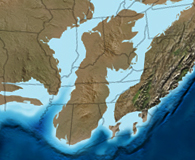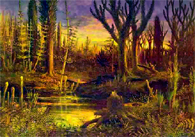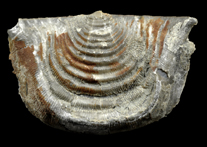After watching 4.45 billion years of Earth evolution, you might not expect to suddenly meet a turtle-toothed fish the size of a school bus. Introducing Dunkleosteus.
Although microscopic enamel fangs had already evolved among conodonts, chewing teeth were making a new appearance -- on a massive scale. Evolved from dermal plates up to two feet thick, combined with the mechanical power of a true jaw, this animal had a bite that could crush any biological object in the Devonian world. Self-sharpening, scissor-like and anchored by massive muscles, this creature's mandibles ruled the seas.
But Dunkleosteus did not swim alone. The Devonian was the "Age of Fish" -- including kinds whose descendents survive to the present day such as boneless sharks, the lobe-fin coelacanth, and ray-fin fishes that you can find today in Tennessee lakes.
Devonian Earth had created a predator on a ten-thousandth fold scale from Ordovician rivals. But evolution had not stopped on land. Stumbling on thickened fins, one fish had chosen to leave the sea. It would inherit a strange new world of low tropical jungles surrounding a disintegrating supercontinent.
To travel back in time to the Devonian era, visit Parson's Tennessee where you can find exposures of the Birdsong shale, rich in fossils from that time. |
|

Devonian Tennessee

Land plants in the Devonian
 Leptaena acuticuspitada, from Parsons Tennessee Leptaena acuticuspitada, from Parsons Tennessee
|